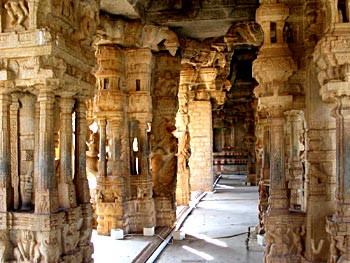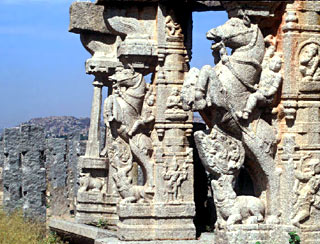 The sculpture of Vitthala temple deserves mentioning for the artistic touch of the then sculptors. The sculptural work of the Vitthala temple involves religious and mythical themes, motifs and other decorative representations. The sculptural work of the Vitthala temple is one of the major elements that has enabled the temple to be enlisted of the important temples of Hampi.
The sculpture of Vitthala temple deserves mentioning for the artistic touch of the then sculptors. The sculptural work of the Vitthala temple involves religious and mythical themes, motifs and other decorative representations. The sculptural work of the Vitthala temple is one of the major elements that has enabled the temple to be enlisted of the important temples of Hampi.
In the sanctum of the Vitthala temple, there is an idol of Bhoga-Ranganatha: Vishnu reclining on the coils of the cosmic serpent, with his two consorts at his feet, though this is not original to the temple. In the antechamber is a large stone slab on which Vira-Anjaneya is carved. It is difficult to determine whether or not this was originally here. Possibly, it was placed here in post-Vijayanagara times.
The reliefs on the mandapa pillars are roughly carved, and are of little interest from the point of view of either sculptural quality or iconographic variety. The most common themes among the pillar reliefs are the squatting lion, the Vaishnava namam (sectarian mark), the conch and the disc. There are a number of vegetal and floral motifs. Among the representations of deities, those of the zoomorphic Matsya and Kurma and reliefs of Narasimha are the most recurrent; the linga is seen a couple of times. A number of reliefs of saints and sages, including the alvars in stereotype poses and Matsyendranatha, occur repeatedly. Animals and birds, such as the lion, cow, monkeys, hamsa and so on, appear occasionally and so do other motifs.
The most interesting sculptures are those of some donors or devotees. On the west wall of the detached mandapa is a finely executed panel of a human group. In front is a turbaned, standing gentleman, who is handing a mala or garland to an ascetic or priest. Behind him are three standing figures, a man and two women, and all three have their hands joined in anjali-mudra. The elaborate coiffures of the ladies are striking, while the man wears a high cap and a buttoned-up jacket. Earrings are worn by all irrespective of men and women. On a rock to the south of the temple is a relief of three standing couples, who are devotee figures, with hands in anjali. The figures are placed within foliated arches. The men wear lungis and jackets; each has a cap or pleated turban, with a small finial, on his head. Both the men and the women wear ear-rings. Around the lamp-pillar in front of the temple are a number of naga stones which are crudely carved stone slabs.
Since there is no foundational inscription to help date the "vimana", one has to do so mainly on the basis of its architecture. The archaic nature of its construction, in the Deccan style, indicates that it is an early monument, possibly of the late fourteenth century. At the latest, it could have been constructed at the very beginning of the fifteenth century. There are two epigraphs from elsewhere, of the first decade of the fifteenth century that may apply to this monument. According to one of the epigraphs it could be that Vitthala of the Prata Vitthala temple was originally called Prasanna Vitthala, and the area around this temple was known as Prasanna Vitthalapura. The name Prata (Old) Vitthala for this deity would have come into use only after the construction of the great Vitthala temple.
 In sixteenth-century records of grants made in the presence of god Vitthala of the great Vitthala temple at Vijayanagara. But since it is not very likely that the great Vitthala temple was in existence in 1408, this could be a grant made in the presence of Prata Vitthala. The next grants that were made in the presence of Vitthalesvara on the bank of the Tungabhadra River are dated AD 1493 and AD 1503, during the reign of King Immadi Narasimha of Saluva dynasty. It is likely that the great Vitthala temple had been erected before or during his reign (AD 1491- AD 1505) for from the sixteenth century many grants were made in the presence of the great Vitthala-deva of Vijayanagara.
In sixteenth-century records of grants made in the presence of god Vitthala of the great Vitthala temple at Vijayanagara. But since it is not very likely that the great Vitthala temple was in existence in 1408, this could be a grant made in the presence of Prata Vitthala. The next grants that were made in the presence of Vitthalesvara on the bank of the Tungabhadra River are dated AD 1493 and AD 1503, during the reign of King Immadi Narasimha of Saluva dynasty. It is likely that the great Vitthala temple had been erected before or during his reign (AD 1491- AD 1505) for from the sixteenth century many grants were made in the presence of the great Vitthala-deva of Vijayanagara.
Regarding the construction of the separate "mandapa" behind the Vitthala temple, it was obviously built after the temple itself was erected, for the inscription within it clearly refers to it as the "mandapa of Vitthalesvara". The attached "mandapa" in front has pillars of the type common to the temples built according to the Tamil temple tradition at Vijayanagara. In the Narasimhapuranam, a late sixteenth-century literary work, it is mentioned that Proluganti Tippana, a commander of Devaraya II (AD 1424-1446), built a "bhoga-mandapa" for god Vitthala. From the early sixteenth century, especially after AD 1513, there are innumerable references to the great Vitthala temple.
The existence of the Old Vitthala temple at Vijayanagara from the late fourteenth or early fifteenth century onwards proves that the cult of Vitthala was not a late importation into the city, as had been held by some historians. It was one of the earliest Vaishnava cults to be incorporated into the capital fairly soon after the establishment of the Vijayanagara kingdom. The early Sangama period saw the promotion of the worship of the Vaishnava deities Narasimha and Vitthala at the site, and possibly also Lord Krishna. The Vitthala cult in the sixteenth century grew from strength to strength: and in the last quarter century before the city"s destruction, it was to overshadow in importance the cult of Virupaksha. The gradual growing popularity of Vitthala at Vijayanagara during the fifteenth century elevated the need was felt to build a larger and more magnificent temple to this deity at the site. Yet, with the construction of the great Vitthala temple, the first temple to this god at the site slowly declined in importance and after AD 1565, its very existence fell into oblivion till it was resurrected recently.
The half-way between the Virupaksha and Vitthala establishments was a zone where both Shaiva and Vaishnava temples and shrines were to be found. The old Vitthala temple lies in this mid-way zone. This is, perhaps, symbolic of the reality that it was constructed at a time when such tensions were at a minimum and the rulers were consciously fostering religious harmony through the promotion of all sects. The Prata Vitthala temple though small, and, in comparison to other larger and more elaborate temples at Vijayanagara, insignificant from the architectural and sculptural points of view, is an important and interesting monument. It throws some light on the evolution of temple architecture at Vijayanagara and on the religious history of the city.
The sculpture of Vitthala temple includes the construction of different subtle details of the deities and artistic works that enhanced the vividness of the temple.



















